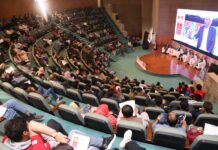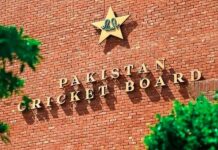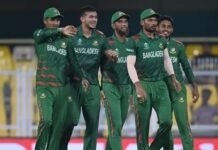AT PENPOINT
While the nation participated in the great patriotic exercise of polling yesterday, in a vote which may determine the direction is going in, and while the contours of the future government may already be visible, it is difficult to avoid the feeling of Pakistan merely being on a democratic bandwagon, as it is just one of the 47 countries going to the polls this year, involving about half of the world’s population.
The region is seeing a rash of elections: the Maldives had its presidential election in September, and Bhutan and Bangladesh its parliamentary poll in January, while both India and Sri Lanka have elections towards the middle of the year. Of course, the world’s most watched election will probably be the US election in November, where it seems that the 2020 contest is heading for a repetition, while the British election, which is not due until next year, but is likely to be held in December. Though not a very strong body, the European Union’s parliamentary polls are due this year too.
An interesting pair of contests is to be held in both of the contestants in the Russia-Ukraine War. Presidential elections are due in both, and while it seems Russia will be going ahead in March as scheduled, Ukraine is a little doubtful, being under Martial Law. In both countries, the incumbents are eligible to run again, with the votes likely to be an assessment of how well they have done as war leaders.
In the local context, the voters will have to assess which party is best able to manage the economy. To focus within that, the electorate will have to ask about which party is going to do its best at bringing down the inflation rate. Note that no one looks for an actual roll back of prices. At the moment, however, it seems that no party has any idea of how to stop the rise, or reduce the speed at which they rise.
Perhaps because no one has a solution, the parties are basing their campaigns on their leaders. The PTI is probably the worst off, not even having its own symbol, but the message is that party chairman Imran Khan must become PM, even though he has been convicted thrice, is in jail, and is not a candidate for the National Assembly. What is to happen after he becomes PM, is not spelled out. Presumably the same milk and honey will flow as when last he was PM.
Similarly, the PML(N) seems to be campaigning on the basis of its being the vehicle for the return of Mian Nawaz Sharif as PM, the fourth time he will have the job. Its message seems to be that he is adept at fixing the economy. That is about as far as an actual economic programme has been presented, even though much of the sheen has been taken off that message by the performance of the recent PDM government, where the PML(N) had charge of the economy, and where its reputation as a good economic manager was ruined. Worst of all was the sight of Finance Minister Ishaq Dar, sent expressly from London by Mian Nawaz, failing to halt the collapse. The PML(N) has so far refused to present a plan, raising the suspicion that Senator Dar may come back as Finance Minister.
It has generally been agreed by all economists and business community leaders that the country needs political stability above all else. The purpose of the election is to generate that stability. But will it? That the election has been held is movement in that direction. But the quality of the government formed does not lead to much hope.
The PPP has been the most up-front of the parties, with a concrete economic programme. However, that programme seems to be a bundle of promises, all of which require money. It is not explained where the money is going to come from. The implicit message, that the IMF might not be obeyed, is also a subtext.
The general assumption seems to be that the new government will have to engage with the IMF, in the hope of getting a programme which will succeed the present Stand-By Arrangement, which is expiring in March, and which merely covered the caretaker period anyway.An unfortunate development for Pakistani governments has been that the risk of default is always hanging over their heads, and the need for foreign exchange is now driven by debt servicing needs.
At the same time, none of the major parties has given out any details of its tax policy, beyond the PML(N) and PPP setting tax-to-GDP targets beyond the present. As the IMF lays great emphasis on the tax-to-GDP ratio, that target might be seen as the parties trying to placate the IMF in advance. However, neither indicates how that target would be achieved. Clearly, there is no incentive to recommend steps that might not be approved by the IMF.
Of course, there is also the ‘selection’ factor. The PML(N) is widely predicted to win, not because of the strength of its manifesto, or the track record of either of the Sharif brothers, but because it has been vaguely hinted that foreign donors would prefer him as PM. Foreign donors, that is, Gulf countries and China, are doubly important, for not only are they sources of foreign investment, but of bailouts whenever past sins (loans) start catching up with us.
Indeed, the impression that the PML(N)) is scheduled to win has been stronger than in any previous election. It should be remembered that this is more the product of paste experience rather than any other reason. Since 1988, the incumbent has always lost. In 1977, we have the only example of an incumbent winning, but the election became so controversial that it is even now quoted as an example. At the same time, it should be noted that there is an international, and a regional, trend towards re-election. However, because of the caretaker mechanism, there is some doubt about who is the incumbent. The caretakers aren’t contesting, nor is the PDM coalition (all its components are contesting as individual parties). The ruling party before that, the PTI, is not even contesting, not having got a symbol; its candidates are contesting as independents.
Another way of looking at it is to see whether the government ousted about three years into the tenure was replaced by someone from the same party or another combination. In 1988, 1990, 1993 and 1996, the Assembly had to be dissolved, and the resulting elections led to the incumbent losing. In 2000, as there could be no presidential dissolution, martial law was imposed. The ousted party, the PML(N) was defeated in the 2002 election.
In that Parliament, the PM resigned, but going forward, the PMs elected in 2008 and 2013 were unseated, while the one elected i n 2018 was removed by a vote of no-confidence. He was also the only one not replaced by someone else from his party.
It thus makes a certain sense that it is being speculated that Mian Nawaz will become PM a fourth time, and then be ousted towards the end of his tenure. While he is Pakistan’s only three-time PM, he also has the unenviable record of being removed from office by all methods except one. He has had his Assembly dissolved by the President (and though it was restored, he was forced to resign), had martial law imposed and been disqualified from the Assembly. All that remains is he be removed by a vote of no-confidence.
It has generally been agreed by all economists and business community leaders that the country needs political stability above all else. The purpose of the election is to generate that stability. But will it? That the election has been held is movement in that direction. But the quality of the government formed does not lead to much hope.























